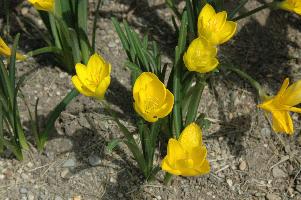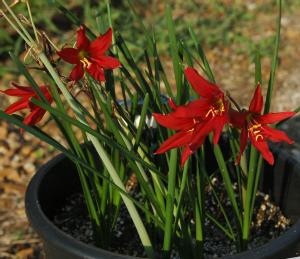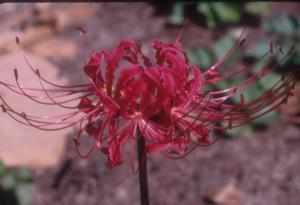I've been busy catching up. I'm still catching up, now with this blog. I missed some flowers that bloomed a month ago, Sternbergia lutea and Rhodophiala bifida.
Catching Up with Blooms
Sternbergia and Rhodophiala are genera in the Amaryllis Family (Amaryllidaceae). Two of their species, at least, seem to be fairly hardy here in central Indiana. As noted, both are Fall blooming, a handy trait where not too many flowers bloom in autumn.

Sternbergia lutea
I have three patches of Sternbergia outdoors in the ground, and all are doing well. One has increased so much that I need to make a note to lift and separate the bulbs next spring or summer. I can make more patches of Sternbergia around the place with them. They seem to be perfectly hardy, but they don't like weed competition.

Rhodophiala bifida (diploid form)
I have one patch of Rhodophiala bifida, the triploid form common in gardens in the Southern States. I just checked on it, and the leaves are up but there were no blooms this year. It is being crowded out by a huge clump of Iris sanguinea (I think). Those will need to be moved next spring if they are to survive. I need to get more of those bulbs and try them in a lot more places.

Lycoris radiata radiata (triploid form)
A species that is not in bloom this year is Lycoris radiata radiata, also a triploid garden form from the Southern States. I have one patch of it, and the leaves are just starting to come up. There are no signs of blooms this year. It may need some mulch in winter, and it may have suffered from lack of water during our hot and unusually dry summer this year. In 2000, it bloomed in early September here. I usually expect to see it bloom sometime in late October.
Catching Up with Currency
I've also been catching up on the catalogs we issue and our prices. You might not have noticed, but the value of the U.S. Dollar against the Euro, the British Pound, and the Japanese Yen has been falling. It has also fallen against the South African Rand, from ca. 7.2 Rand per Dollar down to 6.56 Rand per Dollar yesterday (according to this morning's Wall Street Journal).
I've had to accordingly adjust the selling prices of plants that we buy from South Africa. That will be painful for anyone who has been putting off ordering one of the beautiful 'Cameron Peach' clivias! I certainly regret this for my part.
This will also affect the costs and hence the prices of future batches of 'Chubb Peach' and of 'Cynthia's Dream' plants, all of which come from South Africa. Eventually it will also affect the prices of Belgian hybrids as well.
Catching Up with Yellow Clivia
I've been reorganizing the group 1 and the group 2 yellow clivia types (in my own mind). For the group 1 gene locus, I see the yellows as "group 1 allele a," and the Chubb Peach plants as "group 1 allele b." The orange allele at the group 1 gene locus we can call "allele w" for wild type. Nice and neat, even simple.
The wild type group 1 plants would be [1w/1w] while the yellow group 1 plants would be [1a/1a]. Cross an orange with a yellow, and all the first generation offspring would be [1w/1a]. Chubbs Peach plants could have either [1a/1b] or [1b/1b] at the group 1 loci, since Chubbs Peach seems to be at least somewhat dominant (but see below). All this is pretty straight-forward.
Here is where it gets a little tricky. For the group 2 yellow gene locus, I see the orange form as "group 2 allele w" (again for wild type); the plain yellow as "group 2 allele a." For the yellows that have orange or pink on tepal edges or at damaged spots, it would be "group 2 allele b;" and for the peaches that are compatible with group 2 yellows, "group 2 allele c."
The group 2 wild type oranges would be [2w/2w] while the unspotted group 2 yellows would be [2a/2a]. If 'Sunrise Sunset' really is a group 2 yellow, then it is probably [2b/2b] since it sometimes gets orange or pink spots on the petals. My guess is that 'Tessa' would be [2c/2c]. What would a [2a/2b] look like? What do things like [2a/2c] and [2b/2c] look like? Only a lot more careful breeding experiments or some DNA work, or both, will settle the questions.
I expect that in the long run we may well find that the "dominant" alleles are actually only partially dominant, or dose-dependant. For instance, I see that the flowers of a few of my Chubb Peach seedlings have a much deeper tint of peach than most of them do. Could these few be [1b/1b] homozygous plants while most are heterozygous forms, [1a/1b]? Or do the more intensely colored Chubbs Peach have a new modifier gene that is responsible, located at a different gene locus?
The usual wild type orange Clivia miniata would by [1w/1w; 2w/2w] in my notation -- homozygous for orange at both genes.
Good gardening,
Jim